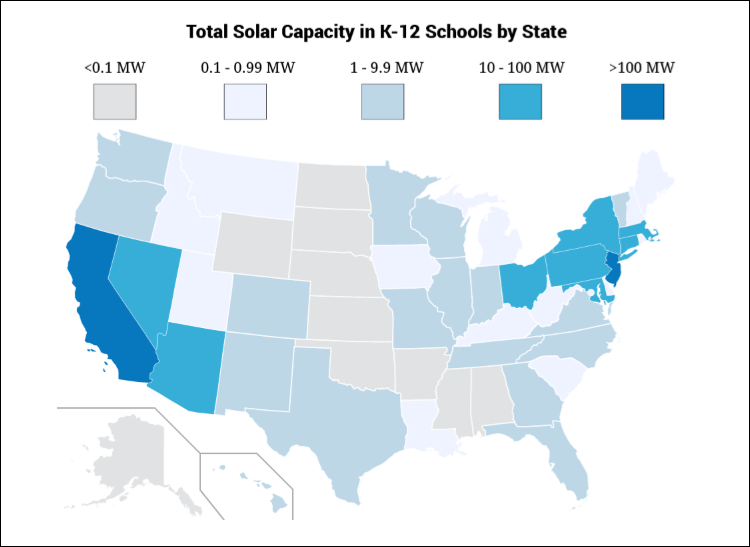Solar Power Savings Give K-12 Districts Money to Spend in Other Areas, Report Says

Nearly 5 percent of U.S. schools now use solar panels to generate electricity. Besides conserving energy, these installations provide utility cost savings that translate into more educational resources for schools, according to a new report from a solar industries group and others.
Rapidly declining installation costs are one major reason for the fact that 5,489 K-12 schools are now using solar energy, according to research from The Solar Foundation, Generation 180, and the Solar Energy Industries Association.
The average cost of an installation for solar power in schools dropped 67 percent over the last decade, and 19 percent in 2016 alone, according to the report, Brighter Future: A Study on Solar in U.S. Schools, 2nd Edition. The first study of its kind was released three years ago.
We asked the Association of School Business Officials International about the degree to which savings in electricity are likely to translate into educational spending.
“You certainly can prove that the dollars are being saved and that schools are truly using the money for education in the classroom,” said John Musso, executive director of the organization, in a phone interview about the report.
In Arlington, Va., Discovery Education School generated enough energy cost savings in 2015-16 from photovoltaic rooftop solar panels that it equaled the salaries of two full-time teachers, according to a new Education Week report. The
The San Diego Unified School District—which had a rocky start with solar power when faulty solar panels needed to be removed from 24 schools five years ago—has continued its commitment despite that setback.
Today, 39 solar photovoltaic systems are installed throughout the 130,000-student district, producing over 4.56-megawatt hours of renewable energy per year and a savings of about $3.62 million annually, said Samer Naji, the district’s facilities communication supervisor, in an email. When the installation of another 20 solar systems is complete by 2019, the savings are expected to increase to about $7.7 million per year.
The solar initiative is part of the district’s “climate action plan” to produce 100 percent renewable electricity by 2035, and reduce landfill waste as well as increase water efficiency. “The cost savings generated by the steps the district has taken to combat climate change significantly alleviate pressure from the district’s general fund,” Naji wrote in the email.
The savings provide “greater flexibility in funding” programs like visual and performing arts, STEM and STEAM initiatives, and language immersion programs, he said.
Power Purchasing Agreements
Districts are often using power purchasing agreements for solar in their strategy to generate energy and save money, according to Musso.
Under these financing options, the up-front investment for solar is minimized. A third party finances, builds, owns, and maintains the system; schools and districts can then purchase solar with a low initial cost. Within the last three years, nearly 90 percent of the schools for which data is available used this arrangement to install solar, according to the solar industry release.
That’s how San Diego is financing its solar expansion now, for instance.
The faulty systems that San Diego installed years ago, produced by a company that declared bankruptcy, helped pave the way for better, safer installations, said Ben Airth, a senior specialist in distributed energy resources at the Center for Sustainable Energy, a nonprofit that provides incentives for using sustainable energy.
“San Diego was the first in California to actually put solar on schools, and it was a lesson for everybody,” said Airth, whose organization ran the incentive program for that failed installation. Among the lessons learned was how to size systems to maximize savings.
“Schools are in a unique position, compared to for-profit businesses that own their buildings or lease buildings,” Airth said in a phone interview. “The benefit they have is that they are going to be in that building for the lifetime of that system…which allows them to enter into long-term agreements where they can maximize their savings.”
Musso, from ASBO, said he anticipates seeing a boost in solar installations. That trend would be embraced by the Generation 180 organization, which maintains a website promoting schools’ participation in solar initiatives.
“More and more, [schools are choosing solar] because resources are getting fewer and fewer,” Musso said. In some cases, schools have used the savings to purchase curriculum, and have incorporated lessons based on solar energy into the curriculum. One California continuation school is teaching solar panel installation to students who could consider that a career choice.
California leads the nation in the number of solar-paneled schools, with 1,946, according to the solar study. New Jersey has the second highest number of installations, followed by Arizona, Massachusetts and New York.
See also:
